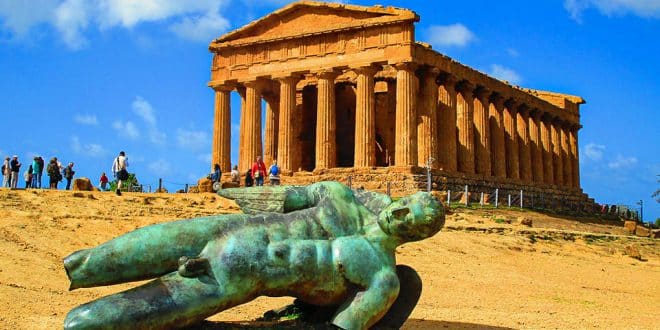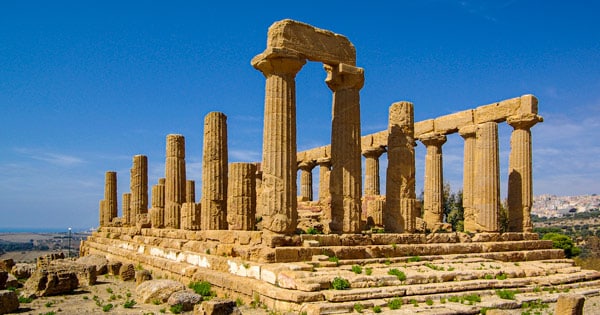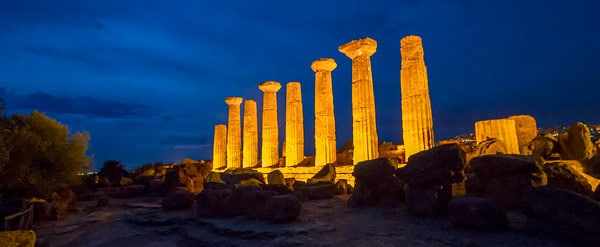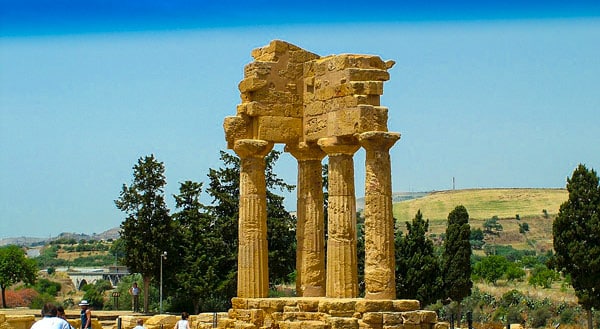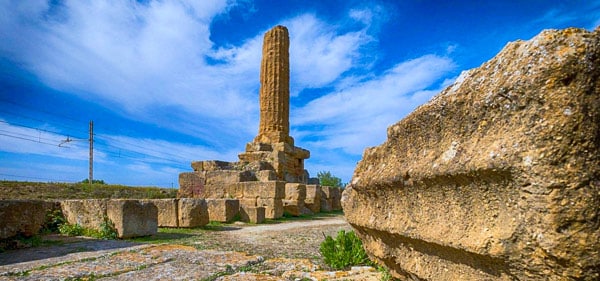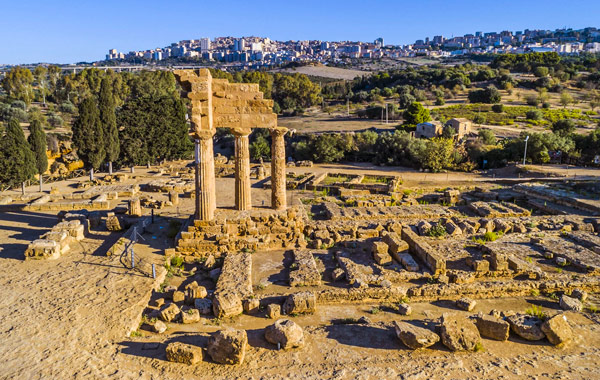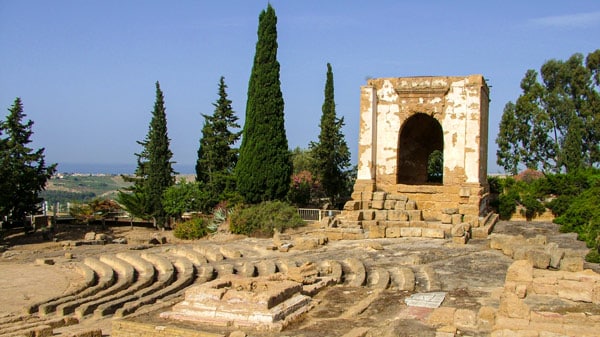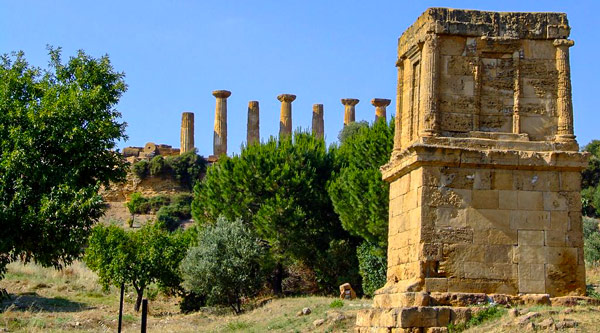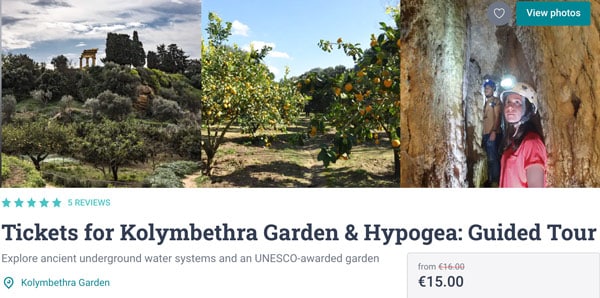If you think that Greece has everything, you’re wrong. Even in this wonderful country, there is no archaeological park as unique as the one preserved in Southern Italy. In the region of Sicilia, near the modern city of Agrigento, you can still go back in time to Magna Graecia and visit the monumental complex, the Valle dei Templi.
In this picturesque setting, you can admire the grandiose buildings of ancient civilization – Doric temples from the 6th to 5th century B.C., dedicated to the world of the gods, but which have fascinated mankind for thousands of years.
The Valley of the Temples is the largest archaeological site in the world, and one of its ancient monuments exceeds in size all other known ancient Greek Doric structures. The monumental complex was included in 1997 in the list of UNESCO World Heritage Sites.
Page Contents
History of the erection of the temples of Akragas
No city in the world has had such a concentration of majestic temples, so striking to the human imagination, as the ancient city of Akragas
– one of the largest Greek colonies in Sicily, together with Syracusae, Gela and Selinunte.
Founded in 581 B.C. by settlers from the Greek island of Rhodes, it developed rapidly and within a century was the richest polis in Italy, surpassed only by Syracuse.
The economic and political heyday of Akragas, from the middle of the 6th century to the end of the 5th century B. C., coincided with an enormous construction boom on a grandiose and unprecedented scale. Rulers of the city, where lived from 200 to 800 thousand people, were just obsessed with the goal to surprise the world, and they succeeded. The majestic temples erected expressed Akragas’ commitment to extravagance and gigantomania, showing its supremacy in the world.
The famous Greek poet-lyricist Pindar, who had seen the world, called Akragas “the most beautiful city among those created by mortal hands.” But even that which had been built for centuries could not withstand the test of wars and natural disasters. As early as 406 BC, Akragas was destroyed by the army of Carthage, led by Hannibal Mago.
All subsequent attempts by the rulers of ancient Akragas to restore the ancient buildings did not bring back the former greatness of the city. Not all the temples survived the earthquakes caused by the volcanic eruption of Etna (Etna) among which the most devastating were in 1401, 1693 and 1968.
Read about earthquakes in Italy
Besides wars and natural disasters, the townspeople themselves have not spared valuable historical monuments. In the eighteenth century, the removal of structures of marble and stone for the construction of buildings in modern Agrigento became widespread.
In spite of the tragic history, some of the ancient temples have survived much better than other famous Doric structures of Ancient Greece.
Read tips for choosing a hotel in Agrigento and a review of the best beaches in Sicily.
Description of the Archaeological Park
The Archaeological Park of the Valley of the Temples is about three kilometers from modern Agrigento and covers an area of 1,300 hectares, and this was only part of the ancient city of Akragas. The area of the archaeological site is commonly referred to as the “valley”, but, geographically speaking, it is an upland, as the temples of Akragas were built on natural plateaus and occupied the highest points of the city.
All the temples of the valley face east; in ancient times, the sun was thought to symbolize light and life. After 25 centuries, the remains of seven Doric temples had been preserved in the southern part of the old town, along with numerous other monuments dating from the ancient period, the Roman era, and the time of early Christianity.
Serious archaeological and restoration works in the Valley of the Temples were initiated in the first half of the nineteenth century by the archaeologist with the title of Duke Domenico Antonio Lo Faso Pietrasanta.
At present, much of the archaeological site is still unexplored, which gives hope to discover new and interesting pages in the history of the Valley of the Temples.
Watch a video with an excellent reconstruction of Akracas:
Temples of Ancient Akragas
The temples were named after the most important Greek gods of Sicily, the Olympus or the Pantheon.
Temple of Concordia
The Tempio dell a Concordia or Concordia is the largest and best preserved Doric temple in Sicily and was probably built between 440-430 BC.
It was named conventionally after a Roman find near the walls with a Latin inscription of the first century A.D., “Concordia degli Agrigrigi” and a Roman inscription of the first century A.D. “Concordia degli Agrigentini.”
Concordia is the Roman goddess of consent in marriage and society; she can be associated with the Greek goddess Homonoia, who personified order and unity in classical Greek politics.
Antique building stands on the crepidoma – a platform of 4 levels, the upper of which in the language of architecture is called stylobate (stilobate), and the lower – stereobates (stereobate). The base of the building is 19.8 m X 42.2 m, the height – 13.5 m, cella – the inner part of the sanctuary is defined 28.36 m X 9.4 m.
The external colonnade is made up of 34 strong, fluted columns 6.7m high, made with an entasis effect, a slight bulging of the element to give strength and harmony to the structure. The ancient structure, unlike the others, preserved almost entirely the elements of the entablature (epistyliorum) and the two pediments on the east and west sides.
The temple is also in good condition because it survived the ravages to which Greek buildings of worship were subjected during the persecution of the pagans in the late Roman Empire.
In the 6th century A.D. the Christian church of Saints Peter and Paul was built in the temple with a significant change in the appearance of the ancient structure: the interior of the colonnade was walled up, the cella was transformed into a nave, the walls and ceilings of the structure were transformed into arched vaults.
Only in 1743 the church was included in the list of national monuments of Italy. After the church was moved to another place, in 1785 during the restoration works the ancient monument was restored to its original appearance.
[The bronze sculpture of the Fallen Angel at the foot of the temple, which gives a certain colour and mystical touch to the ancient ruins, but not to the time of its creation, can not be missed on the excavation site. The author is the Polish-born artist Igor Mitoraj, who is famous for his works in the antique style.[/box]Temple of Hera
Adjacent to the Temple of Concordia on the highest point of the valley are the remains of the Tempio di Hera Lacinia or Tempio di Giunone Lacinia, the goddess of marriage, family and procreation.
It was built around 450 B.C. and belongs to the Doric period. Like all temples of the time, it was built according to the canons of Greek town planning and bears a resemblance to the neighboring structure.
It was once surrounded by an impressive colonnade of 34 columns, but only a few have survived to this day on the northern side. The stylobate measures 38.15 m long and 16.90 m wide, and is 6.44 m high. The walls still show the traces of the fire that took place in 406 B.C. when the city was destroyed by the Carthaginians.
Under Roman rule attempts were made to reconstruct the temple; it is known that the roof was replaced by a marble roof. The attribution of the names of Hera and Juno to Lacinia was inspired by another temple dedicated to Juno in southern Italy, not far from the ancient port city of Croton, where the forests of Lacinia extend.
In the times of the Greeks this temple was used for wedding ceremonies. In the 18th century the ancient monument was restored to its present form with the original architectural elements that had survived.
Temple of Hercules
Not far from the alleged agora (ancient Greek square) was built the Temple of Hercules (Tempio di Eracle) or Hercules (Tempio di Ercole). It is possible that this name belonged to the temple because manuscripts have survived in which Cicero mentions it as the closest to the agora and having a statue of Hercules inside.
It dates from the 6th century BC and is the oldest surviving temple in the valley. The dating was done on the basis of an analysis of the architectural style and proportions of the other temples of the period.
Unlike the other temples of Akragas it has a more elongated form (length – 67.0 m, width – 25.34 m), a different profile of capitals and columns, of which there are 38 on the perimeter, and a large altar on the east side. In the surviving remains of the building we can see traces of an internal staircase which was used to repair the roof.
Some architectural details, such as the entablature, are of different styles, confirming that the temple was rebuilt more than once. The nature of the ruins indicates that the main destruction was caused by an earthquake. In 1922 the 9 columns of the temple were raised and reinforced at the base.
Temple of Olympian Zeus
The architectural park of the valley preserves the ruins of the largest Doric temple ever built, the Temple of Olympic Zeus or Olympeion (Tempio di Giove Olimpico).
It was presumably begun under the tyrant Gelonas and was dedicated to the victory over the Carthaginians in 480 B.C. at the Battle of Gemera, one of the most important battles in Sicily, which weakened Carthage for several decades.
According to the ancient historian Diodorus of Sicily (Diodorus Siculus) the labor of the Carthaginian slaves taken prisoner was used to build the temple. The final completion of the construction was prevented by the same old enemy in the face of Carthage whose troops in 406 BC first besieged and then sacked Akragas.
An earthquake in December 1401 BC completely destroyed the building. All that remains today is a wide platform with fallen columns and shapeless blocks of stone.
Originally the temple had impressive dimensions: the stylobate was 112.7 m by 56.3 m, and the height of the columns was 14.5 m to 19.2 m. The whole structure was built of small stone blocks and had a five-stage crepidoma at the base; each column stood on a platform 4.5 m above the ground. The long sides of the temple had 14 semi-columns, the short sides had 7, and their design was an archaic feature. The columns had a girth of about 4.3 meters and a person could fit into its grooves.
Another distinctive feature was the attachment of the outer columns to the wall necessary to support the entire massive structure. Between the columns were stone statues of huge Atlanteans, about 7 meters high. The figures were an alternation of bearded and clean-shaven nude giants supporting the roof of the temple with arms bent over their heads.
Miraculously, archaeologists and art historians have managed to assemble the Atlantean from the remaining whole parts. The original statue is housed in a nearby archaeological museum, and its copy protects the ruins of its temple. In front of the eastern facade lies the base of the great altar (54.50 m. x 17.50 m.); this is where the bulls were sacrificed in honor of Zeus.
The Temple of the Dioscours
A symbol of Agrigento is the Tempio dei Dioscuri, built in the 5th century B.C. Its image can be seen in many guidebooks and travel agency advertisements.
The time has not spared this architectural masterpiece of antiquity, and only its ruins have survived. In 1836 archaeologists and enthusiasts cleared the site with the surviving fragments and stone blocks of the structure, raised four columns and gave the fragmented part of the temple the appearance that can be seen today.
Excavations have shown that at the site of the Temple of Dioscurus, around the middle of the 5th century BC, there was an older sanctuary, most likely belonging to the natives of the island, the sicani, who worshipped deities no longer known to the present day.
Temple of the Volcano
Most famous for the Temple of Vulcano or Tempio di Efesto, built in 430 BC in the southwest part of the city. Only the remains of its two columns are sufficient to judge its former grandeur.
The dedication to the fiery Roman god Vulcan, the personification of a formidable natural phenomenon, can be explained by the fact that for centuries the inhabitants of the land of Sicily had felt the presence and wrath of underground lava fires and tried to placate the furious Vulcan – it was one of the oldest deities, known in Greece as Hephaestus, god of fire and blacksmithing.
It can be assumed that the place of fire worship was also a place of cremation by analogy with the most ancient sanctuary of Vulcan in the Roman Forum (Foro Romano). Perhaps the custom inspired the tyrant of Akragas – Falaris to create a monstrous instrument of torture and death – the copper bull Falarid, in which criminals and people unwanted by the ruler were roasted alive with horrible inhuman cries.
Temple of Asclepius
A little further south from the city walls is the temple of Asklepios (Tempio di Asclepio), the ancient Greek god of healing.
The sick flocked to its walls in the hope of begging for a miracle cure. Clay figurines of body parts have been found near the ruins, which were gratefully carried to the temple by those lucky enough to be cured.
“Diagnosis” of the disease was carried out directly in the temple, namely in its main part, the abaton (abaton). The patient would stay there overnight, and in the morning would tell the priest about his dreams, which, as a result of the interpretation of the “chief physician”, resulted in the appropriate treatment. In such temples they kept, as a rule, “sacred” dogs and snakes, which in contact with the sick also helped them to get rid of grave ailments.
The bronze statue of Apollo, created by the ancient Greek sculptor Mirone and given to the temple by the Roman commander and politician Scipio Africanus (Publius Cornelius Scipio Aemilianus Africanus), was the most valuable part of the interior. Later, a century and a half later, it was taken to Rome.
Interesting fact: in Rome, the temple of Aesculapius was located on the island of Tiberina (Isola Tiberina).
Other attractions of the Valley of the Temples
The layering of the centuries in the Valley of the Temple allows you to see the traces of culture and religion from different periods of Akragas history, and the excavations that have been carried out draw the shape and way of life of the ancient city.
City Wall and Gate
Fragments of the mighty city wall of Akragas, built of rock with a length of about 12 km along the perimeter, can still be seen near the Temple of Concordia. Archaeologists managed to find the location of all nine gates of the fortification, which were repeatedly rebuilt, until the end of the IX century AD.
Temple of Chthonic Deities
The Temple of the Cthonic Deities (Santuario delle divinita Ctonie) is in fact the center of a series of adjoining religious buildings dedicated to deities who personified the powers of the earth and of the underworld.
In ancient Greece, Chthonia or Gaia, goddess of the earth, as well as Demeter (patroness of agriculture) and Persephone (goddess of fertility and the realm of the dead) were worshipped. To the south of the area lies the Temple of the Dioscurus and close by are the remains of smaller temples and numerous altars, the earliest of which dates back to the 6th century BC.
Necropolis
Between the Juno and Hercules Temples extends a vast area of the early Christian cemetery, which dates from the 3rd to the 6th centuries B.C. It consists of 130 burial places in stone sections. On the remains of the rock wall between the Temples of Juno and Concordia is an arched necropolis of the Byzantine period.
The biggest tombs were in the catacombs of the Grotta Fragapane (Grotta Fragapane), which date back to the IV century A.D. The tunnels and small chambers for the remains of the early Christians are extant today.
The Roman necropolis of the 2nd and 3rd centuries AD, known as Necropoli Giambertoni, is on the right side of the Grotta Fragapane and contains the remains of calcareous tombs with burial sarcophagi.
Other small underground tombs to the east and south of the old city were also used for burials. Access to view the necropolises is convenient from the Via dei Sepolcri, which has itself become an exclusive part of the exhibition route in the archaeological park of the Valley of the Temples.
Ecclesiasterion
The Ekklesiasterion is an important place in the city for folk gatherings (ekklesia), located next to the regional archaeological museum.
This ancient structure has been dated to between the 4th and 3rd centuries B.C. Similar in structure to the Greek theater, the Ekklesiasterion had 19 rows of stone steps and could seat 3000 people. In the 1st century B.C. it was replaced by the Oratorio di Falaride which was a small temple designed for private worship of the deities.
Tomb of Theron
Tomb of Terone is a late Hellenistic tomb in the form of a small rectangular tower, originally with a spire roof.
Near the Temple of Hercules it was erected as a memorial to the tens of thousands of Romans who fell in the First Punic War in 262 B.C. It was mistaken for the tomb of Teron, the tyrant Acragas, who died in 472 B.C.
Gymnasium
Archaeologists have discovered that the men of Akragas attended the Gymnasium (Ginnasio), a structure from the Roman period designed for sports activities.
The gymnasium was located to the north of the Temple of Zeus and dates back to the reign of Octavian Augustus. The athletes used the altars to praise their gods for their victories in the competitions. In the early 4th century A.D. the gymnasiums were demolished to make way for markets and warehouses and in the Middle Ages it was the crafts zone of the city.
Theater
It would be strange if a city as prosperous as Akragas did not have a theater. Its location and traces of buildings to the south of the Roman quarter were only found by archaeologists in 2016. The theater was built presumably in the II century BC according to all canons of Greek architecture and is similar to the ancient theater in Segesta.
Unfortunately, there are no significant structures left to see. The theater itself has been identified only from the layout of the remains of the building and from fragments of terracotta masks and statuettes.
Roman Quarter
A large area of 10 thousand square meters is occupied by a residential Hellenistic Roman Quarter (Quartiere Ellenistico Romano), consisting of 27 houses. There were also stores, warehouses, water collection cisterns and an above-ground sewage system. Fragments of the mosaic floors of the dwellings with geometric, plant and zoomorphic motives are partly preserved and can be seen in the Archaeological Museum of Agrigento.
Colimbetra Garden
In addition to its archaeological value, the Valley of the Temples Park has a beautiful and unusual landscape.
Among the lush vegetation of the garden there are traces of an artificial reservoir about 1 km long, it was dug by the Carthaginians prisoners after the famous battle of Gemera. The word “kolymbetra” the ancient Greeks called the pool for water sports. To fill it, the tyrant Theron ordered the construction of a network of underground tunnels that collected the waters of mountain rivers. Traces of the peculiar aqueduct are still preserved today in the lower archaeological layer of the park (entrance for an extra fee is possible from the west side of the Temple of Dioscury). Apparently, this place was a real resort for the townspeople.
After the desolation of the basin, reeds were planted on its fertile ground and later a luxurious garden gradually appeared on the site. In 2007 and 2009, the Colimbetra Garden was included in the rating “The most beautiful park in Italy”.
The Archaeological Park of the Valley of the Temples strikes the imagination of anyone. It is truly a monumental complex – a witness to the prosperity of Great Greece in the Mediterranean and a world cultural treasure. A walk in the open-air museum will be an incredible pleasure to contemplate the ancient stone masterpieces against a backdrop of charming southern scenery.
Opening times and tickets
Before visiting the ancient sites, a visit to the Regional Archaeological Museum (Museo archeologico regionalale “Pietro Griffo” di Agrigento) is a must, situated on the site of an ancient agora located at Contrada San Nicola, 12.
The halls of the museum by topographic and chronological criteria have interesting displays of ancient artifacts from tombs and sanctuaries, remarkable models of temples, as well as its main exhibit – a stone atlant.
A visit to the museum costs 8 euros,
Open daily from 09.00 – 19.30 (last entry half an hour before closing).
Tickets to the Valley of the Temples: 12€, free for children under 18.
Official website: www.parcovalledeitempli.it
how to get to Valley of the Temples from Agrigento?
The Valley of the Temples is 3 kilometers from Agrigento Centrale train station. The best way to get there is to rent a car; the alternative is to walk 30 minutes from the station.
You can leave the car in the parking lot near the museum.
 Italy for me From Italy with love
Italy for me From Italy with love

